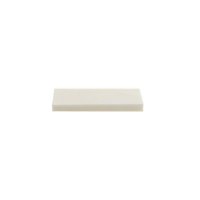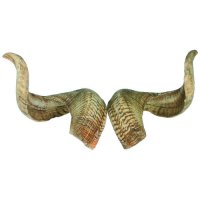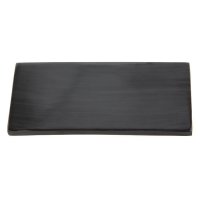Origin, properties, and usage
The very hard material, which can still be worked with flint, was used for blades, composite bows, hammers, sewing needles, spearheads, fishhooks, bows or fittings as well as for jewellery, inlay work, cases or wind instruments. Due to the lack of wood, antler and bone material was the most important material in the polar culture area for thousands of years to ensure survival under arctic conditions. Even today, Sami knife handles and scabbards are preferably made from reindeer antler.
Because of its structural similarity, bone material is now a popular substitute for (species-protected) ivory and is used in this context in restoration, inlay work and components for musical instruments, e.g. claviature.
Antler
Unlike horn, antlers consist of bone substance. Chemically, it is a matrix of approx. 60% mineral salts (mainly calcium phosphate), interspersed with collagen (fibrous protein). The calcium phosphate gives the antlers hardness, the collagen provides elasticity.
Antlers are obtained from deer, roe deer, elk, or reindeer (zoologically cervids), either from shedding poles (antlers grow back annually and are shed in late autumn) or as a by-product of killed animals. Only in the case of reindeer does the females also produce antlers, which, however, are hardly used due to their smaller size and lower hardness.

The poles are solid at the ends and shovels, as well as around the rosebuds, and otherwise porous at the core. The hardness increases while in growth, the best material is provided by fully formed autumn antlers or shedding poles. The brownish discolouration stems from blood from the detaching basal skin at the end of antler formation and plant juices that penetrate the bone substance during the beating of the antlers into bushes and trees. Longer periods of lying in the ground can cause antlers and bones to change colour, turn brown and marbleize, which is popular with knife makers. However, the lying time is usually accompanied by brittleness of the material, which may therefore have to be chemically stabilized before processing.
Animals that live freely, are not fed and grow up in rather harsh conditions develop firmer and finer-structured antlers. This is particularly important when the material is used for scrimshaw engravings, carvings, knife handle scales, etc.
Bones
Bone material is mainly obtained from the thigh-bones of cattle, horses, buffaloes, camels or even giraffes. The bone marrow is removed, and the bone is sterilized by boiling for a short time. For degreasing, a little washing powder (1/2 cup per 5 l) can be added during cooking. Boiling for too long makes bone and antler material brittle as the collagen is dissolved out.
A weak vinegar solution also serves to disinfect. However, caution is advised here as well, since acids dissolve the calcium phosphate with prolonged exposure and thus soften the material.
Processing
Mechanical processing
Antler and bone material is hard and brittle and therefore difficult to cut, but it can be ground and polished well.
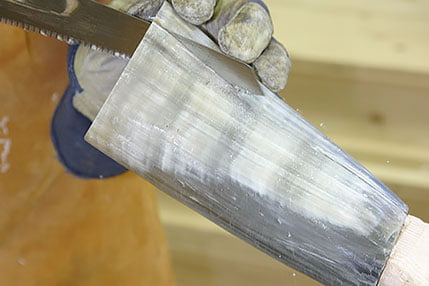

Fresh antler and bone material can be cut with a robustly toothed Japanese saw. For finer cuts on hard, seasoned material, the use of metal saws is recommended. Caution is advised when using band or circular saws. There is a risk of overheating and jamming due to softening of the material! Saw at low speed and cool with water. Allow thicker cuts to dry slowly and under cool conditions to avoid cracks.
- Shaping antlers
Use fine metal or diamond files and abrasives for shaping.. Finish the surface with abrasive cloth followed by Micro Mesh Soft Pads, adding water to a high gloss polish. Alternatively, traditional polishes such as Pumice Powder and Diatomaceous earth, bound with water, can be used on a cotton cloth or by buffing wheel. Oil should only be used as a lubricant or polish after prior testing, as it may cause yellowing of the material. Avoid coloured polishing pastes as well as other colouring agents (metal dust, etc.), as these can hardly be removed from the surface.
- Antler as material for scrimshaw and engraving techniques
For scrimshaw and engraving techniques, the usual tools used in metalworking are used, e.g. etching needles.
- Antlers as turning material
It is also possible to turn with a sting-shaped, scraping tool at low speed.
Plastic deformation (bending)
Bone and horn material can be made pliable by prolonged soaking or boiling in a strongly diluted hydrochloric acid or acetic acid. However, the process is not reversible! The parts therefore remain elastic like rubber even after drying.
Bonding
As with all bonded joints, it is advantageous to roughen the surfaces of the two bonding partners, e.g. with sandpaper grain size 60. The surfaces must be thoroughly degreased before bonding. You can use a solvent such as acetone, but it is better to clean the surface with a scouring agent and water (binds the grease as opposed to the solvent).
The traditional glue for these natural materials is glutin glue, which is obtained from skin or bone material. It is available both as hot Hide Glue granules and as liquid instant Hide Glue. It hardens transparently, has high strength in all organic adhesive pairings (horn, bone, wood, tendons, etc.), but is not waterproof.
- Adhesive for bone/antler on metal
Epoxy resin gluehas proven itself for bone/antler-metal pairings (knife handles). It is transparent and fills gaps, and is therefore also well suited for porous surfaces. Mixed with fine sanding dust (grain size min. 220), slow-setting epoxy is also well suited as a pore filler or for concealing small cracks or surface defects.
- Adhesive for bone/veneer on oily wood
Very reliable bonding, even with oily woods, is achieved with a resorcinol resin adhesive, which, however, does not cure transparently.
- Bone-on-bone adhesive
Cyanoacrylate glue (fast-action glue) can be used for bonding smaller bone parts to each other; it is also suitable for correcting small surface defects.
Bleaching, staining, surface
If desired, bone/tissue material can be bleached. This is especially recommended for plates that are used to imitate ivory or are subsequently dyed.
The dry bones are treated with hydrogen peroxide (brushed or dripped with cotton wool).
Care must be taken not to get hydrogen on the antlers or horns during this work.
Cover the vessel, make intermediate checks, use rubber gloves!
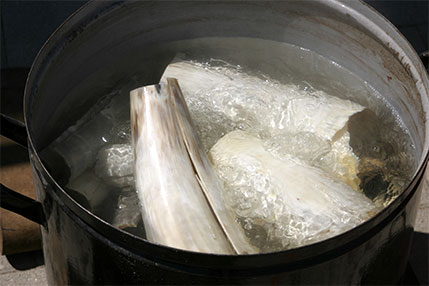
Then rinse the piece in lukewarm water and let it dry slowly.
Bone material can be coloured by prolonged soaking in spirit-soluble mordant, natural dyes such as alkanet or black tea are also suitable.
To prevent polished bone material from drying out and thus going blind, you can either polish it regularly with a non-resinous oil (e.g. camellia oil) or wax, or you can apply a thin shellac sealant. This preserves or even enhances the gloss, makes the material insensitive to hand perspiration and prevents brittleness. Shellac is, however, sensitive to solvents and cleaning agents.
Watch out for your hands!
Human skin is also very sensitive to hydrogen. Hydrogen peroxide must therefore always be kept closed, well labelled and safe.
Caution - risk of chemical burns!
Use only in a well-ventilated room, no guarantee and liability!
Mechanical processing
Bone and antler material that has been exposed to erosion over many years often develops a beautiful patina or strikingly textured surface that is sought after by knife makers. Unfortunately, this fossil material is usually also brittle and fragile. A remedy can be found by stabilizing it with synthetic resin. Either thin acrylic resin or epoxy resin, which hardens anaerobically, is used for this purpose. The latter in particular produces a very stable and wear-resistant bond that is completely resistant to water and to a large extent to acids.
Negative pressure is required to fully penetrate the material. For this purpose, the container with the part inserted in the resin must be placed in a negative pressure chamber and held until no more bubbles appear. You can make a temporary vacuum chamber yourself with the help of a water jet pump and a pressure-resistant glass bell jar. In the professional field, a so-calledDesiccatoris used for this purpose.
Note: The PEG (polyethylene glycol) method commonly used for wood cannot be used for fossil, dried bone material, as it is based on replacing stored water with PEG.
Care
Bone and antler materials are not only durable, they even gain patina through use if a few care instructions are followed:
- Do not expose to dry heat (spotlights, sun) for too long.
- Do not store in too dry a place
- Do not put them in the dishwasher, in water or in boiling food for too long.
- Do not clean with household cleaners containing solvents or abrasive cleaners. Rinsing with warm water and light soapy water is sufficient.
- Do not exert high bending loads
- - Occasionally rub with camellia oil or Ballistol and polish again.
Note: The PEG (polyethylene glycol) method commonly used for wood cannot be used for fossilized, dried bone material, as it is based on replacing stored water with PEG.

